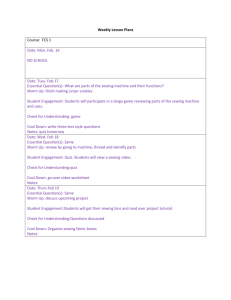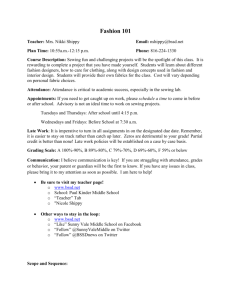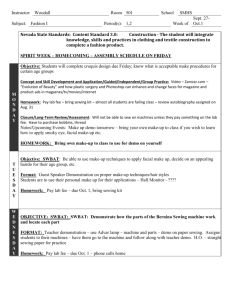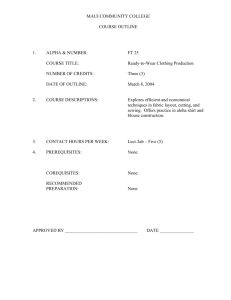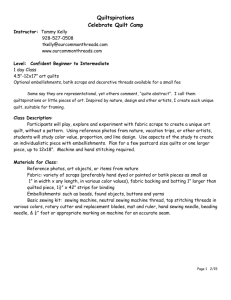Human Factor Considerations in Sewing Machine for Workstation
advertisement
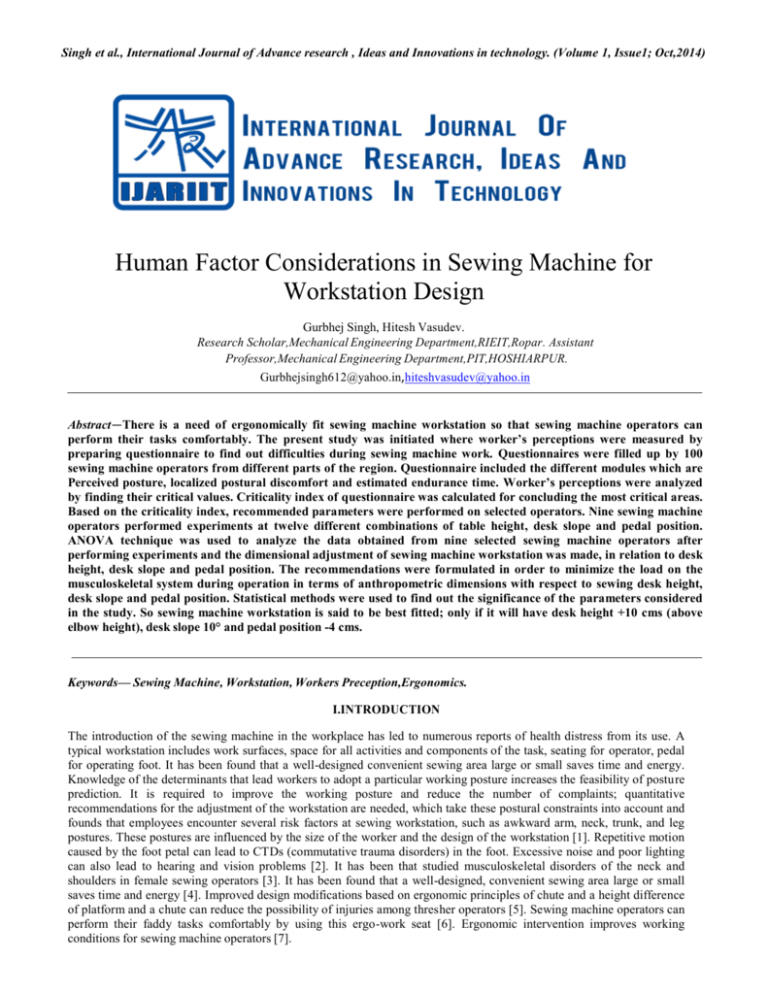
Singh et al., International Journal of Advance research , Ideas and Innovations in technology. (Volume 1, Issue1; Oct,2014) Human Factor Considerations in Sewing Machine for Workstation Design Gurbhej Singh, Hitesh Vasudev. Research Scholar,Mechanical Engineering Department,RIEIT,Ropar. Assistant Professor,Mechanical Engineering Department,PIT,HOSHIARPUR. Gurbhejsingh612@yahoo.in,hiteshvasudev@yahoo.in Abstract—There is a need of ergonomically fit sewing machine workstation so that sewing machine operators can perform their tasks comfortably. The present study was initiated where worker’s perceptions were measured by preparing questionnaire to find out difficulties during sewing machine work. Questionnaires were filled up by 100 sewing machine operators from different parts of the region. Questionnaire included the different modules which are Perceived posture, localized postural discomfort and estimated endurance time. Worker’s perceptions were analyzed by finding their critical values. Criticality index of questionnaire was calculated for concluding the most critical areas. Based on the criticality index, recommended parameters were performed on selected operators. Nine sewing machine operators performed experiments at twelve different combinations of table height, desk slope and pedal position. ANOVA technique was used to analyze the data obtained from nine selected sewing machine operators after performing experiments and the dimensional adjustment of sewing machine workstation was made, in relation to desk height, desk slope and pedal position. The recommendations were formulated in order to minimize the load on the musculoskeletal system during operation in terms of anthropometric dimensions with respect to sewing desk height, desk slope and pedal position. Statistical methods were used to find out the significance of the parameters considered in the study. So sewing machine workstation is said to be best fitted; only if it will have desk height +10 cms (above elbow height), desk slope 10° and pedal position -4 cms. Keywords— Sewing Machine, Workstation, Workers Preception,Ergonomics. I.INTRODUCTION The introduction of the sewing machine in the workplace has led to numerous reports of health distress from its use. A typical workstation includes work surfaces, space for all activities and components of the task, seating for operator, pedal for operating foot. It has been found that a well-designed convenient sewing area large or small saves time and energy. Knowledge of the determinants that lead workers to adopt a particular working posture increases the feasibility of posture prediction. It is required to improve the working posture and reduce the number of complaints; quantitative recommendations for the adjustment of the workstation are needed, which take these postural constraints into account and founds that employees encounter several risk factors at sewing workstation, such as awkward arm, neck, trunk, and leg postures. These postures are influenced by the size of the worker and the design of the workstation [1]. Repetitive motion caused by the foot petal can lead to CTDs (commutative trauma disorders) in the foot. Excessive noise and poor lighting can also lead to hearing and vision problems [2]. It has been that studied musculoskeletal disorders of the neck and shoulders in female sewing operators [3]. It has been found that a well-designed, convenient sewing area large or small saves time and energy [4]. Improved design modifications based on ergonomic principles of chute and a height difference of platform and a chute can reduce the possibility of injuries among thresher operators [5]. Sewing machine operators can perform their faddy tasks comfortably by using this ergo-work seat [6]. Ergonomic intervention improves working conditions for sewing machine operators [7]. Singh et al., International Journal of Advance research , Ideas and Innovations in technology. (Volume 1, Issue1; Oct,2014) II.MATERIALS AND METHODS Methodology of research work consists of three stages i.e. survey stage, experimentation stage and analysis stage 2.1 SURVEY STAGE Questionnaires were prepared to record the perceptions of sewing machine operators. This method of data collection is quite popular, particularly in case of big enquiries. A questionnaire was consisted of number of questions printed in a definite order on a set of forms. The questionnaires were directly filled up by the sewing machine operators. Questionnaire was structured based i.e. there were definite, concrete and predetermined questions and questions were presented with exactly the same wording and in same order to all the sewing machine operators and these questionnaires were filled up by sewing operators directly by approaching to them. Questions contained in questionnaire were simple, easy to understand. This method of collecting data from sewing machine operators was free from bias. Sewing machine operators had enough time to give well thought answers. Quite often, questionnaire is considered as the heart of a survey operation. Hence it should be very carefully constructed. If it is not properly set up, then the survey is bound to fail. By keeping this into mind, questionnaire was prepared properly and then was distributed to sewing machine operators directly, in order to collect their responses. Questionnaires were filled up by 100 sewing machine operators from different parts of the region. Workers’ perceptions were recorded by a questionnaire, containing four questionnaire modules. Critically Index was calculated in each of the module of the questionnaire, in order to find out the critical areas. Critically Index was calculated as:- Multiply point scale of that module of the questionnaire with their individual score of concerned part and add then divide the obtained result with total of the point scale of that module of the questionnaire. 2.2 EXPERIMENTATION STAGE Critical areas were found related to perceived posture, localized postural discomfort, estimated endurance time, Judgment on whole workstation adjustment modules of questionnaire. Based upon these critical areas, recommended Parameters related to sewing machine workstation, were decided. Experiments were performed on various recommended parameters on selected sewing machine operators. 2.3 ANALYSIS STATE ANOVA technique was used to analyze the data obtained from selected sewing machine operators after performing experiments and recommendations were drawn for sewing machine workstation. Analysis, particularly in case of survey or experimental data, involves estimating the values of unknown parameters of population and testing of hypotheses for drawing inferences 2.4 DOMAIN OF WORK Questionnaires were filled up by 100 sewing machine operators from different parts of the region. The sample of 100 tailors on random basis from villages, towns and cities of Punjab state and also included some parts of Haryana state for the preparation of the questionnaires related to the tailors was taken. On the other hand, the sample of 9 tailors on random ba sis for performing the practical work was taken. Only 9 tailors were considered for practical work because only 9 tailors were available for practical work, others were not available because of their work schedule. 2.5 EXPERIMENTATION STAGE Critical areas were calculated, related to four modules of the questionnaires, with the help pf criticality index and those a reas were observed in order to find out the relation with parameters pf sewing machine and critical areas which were recommended the related parameters are shown in table 4. Table 1 SEWING MACHINE AND CRITICAL AREAS Critical areas Posture of neck Recommended parameters Desk slope Posture of left lower leg Pedal position Posture of right lower leg Pedal position Singh et al., International Journal of Advance research , Ideas and Innovations in technology. (Volume 1, Issue1; Oct,2014) Discomfort of whole body Desk height, desk slope, pedal position Whole workstation adjustment Desk height, desk slope, pedal position Table 4 shows critical areas, which were recommended the related parameters of treadle sewing machine. The recommended parameters were desk height, desk slope, and pedal position of the treadle sewing machine. These parameters were further taken into account while performing experimentations on selected treadle sewing machine operators. Experiments were performed on selected 9 treadle sewing machine operators. Here the general information is given of selected 9 treadle sewing machine operators.. This information of sewing machine operators are related with various factors which includes age in years, height in foot-inches, eye sight: ok or not ok, weight in kg. All these factors are shown in table 4, related with selected 9 treadle sewing machine operators. Height of person varies from person to person. That is why desk height was tested related to individual elbow height of sewing machine operator taken as: + 5 cms above elbow height., + 10 cms above elbow height, + 15 cms above elbow height and Desk slope taken as: 0° based on desk slope at shop of sewing machine operator (normal desk). 10° slope towards sewing machine operator. III. RESULTS AND DISCUSSIONS In survey stage, sewing machine operator’s perceptions were recorded with the help of questionnaire. The crit ical areas were found with the help of criticality index and parameters for treadle sewing machine were recommended for experimentation stage. In experimentation stage, 12 sets of experimental conditions were tested for different combinations of desk height, desk slope and pedal position. The existing parameters of the sewing machine operators were measured when they were asked to work for 40 minutes and the following were the findings. Table 2 RESPONSES OF 9 SEWING MACHINE OPERATORS RELATED TO DIFFERENT COMBINATIONS OF PARAMETERS. Desk height Pedal position -4 cms 5 cms. 10 cms. 15 cms. Desk slope 0° 3 5 3 Desk slope 6 9 4 Desk slope 0° 5 6 5 Desk slope 10° 1 6 1 10° Pedal position +6 cms 3.1 ANALYSIS STAGE Analysis means the composition of certain indices or measured along with searching for patterns of relationship that exist among the data groups. Analysis, particularly in case of survey or experimental data, involves estimating the values of unknown parameters of the population and testing of hypotheses for drawing inferences. Analysis of above data, which was collected from 9 sewing machine operators, has been done by ANOVA technique. Analysis of variance is an extremely useful technique in the field of research. The ANOVA technique is important in the context of all those situation where we want to compare more than two populations. If we take only one factor and investigate the differences amongst its various categories having numerous possible values, we are said to use one-way ANOVA and in case we investigate two factors at the same time, then we use two-way ANOVA. Result we obtained by testing 12 sets of experimental conditions for different combinations of desk height, desk slope and pedal position. Analysis of data collected from 9 treadle sewing machine operators was done by ANOVA technique. Thus result obtained from analysis of data is shown that there is significant relation between desk height, desk lope and pedal position. So sewing machine work station design is said to be best fitted only if it will have following combination as given in table 7 and shown as under: Singh et al., International Journal of Advance research , Ideas and Innovations in technology. (Volume 1, Issue1; Oct,2014) Table 3 DIMENSIONAL ADJUSTMENT OF SEWING MACHINE WORKSTATION. Desk height (above elbow height) +10 cms. Desk slope 10° Pedal position (i.e. pedal axis behind the needle) - 4 cms 3.2 RECOMMENDATIONS FOR AVERAGE INDIAN PEOPLE (MALE) Elbow height of average Indian people is 61.0 cms. So as per the obtained result, height of sewing machine desk should be adjusted at a distance of 71.0 cms. from base of sewing machine table. Recommended sewing machine desk height for average Indian sewing machine operators is given in table 8, with different values i.e. minimum. 5 th percentiles, 50thpercentiles, 95th percentiles and maximum. Fig. 1 12 sets of experimental conditions are shown. Pedal position was taken as: 4 cms.to the operator’s side of the needle tip. 6 cms.to the opposite side of the needle tips. These two readings were taken on the behalf of sewing machine builder’s perceptions. Experimentation phase was consisted of 12 sets of experimental conditions. Total SEC (set of experimental conditions) = 12 i.e. 5 0 4, 4 10 4, 5 0 6, 5 10 6, 10 0 4, 10 0 6, 10 10 4, 10 10 6, 15 0 4, 15 0 6, 15 10 4, 15 10 6. IV.CONCLUSIONS It has been concluded that “Ergonomic considerations” should be taken into account while designing a sewing machine workstation.From the questionnaire part, the conclusions related to four modules of questionnaires, were drawn with the criticality index on order to find the most critical areas and given as under: Singh et al., International Journal of Advance research , Ideas and Innovations in technology. (Volume 1, Issue1; Oct,2014) Perceived posture: The critical areas in perceived posture discomfort reveals that the most critical posture of left lower leg, posture of right lower leg. Localized postural discomfort: Localized postural discomfort reveals that the most critical areas is discomfort of whole body and the others discomfort of back, discomfort of left leg, discomfort of right leg, discomfort of upper neck/back. Judgment on workstation adjustment: Judgment on workstation adjustment reveals that judgment by operator for desk slope, desk height, pedal position and judgment of operator for whole workstation have an average effect on sewing machine operator. So from questionnaire part, it was concluded that there was a need of ergonomically fir sewing machine workstation, which the researcher has proved. 4.1 EXPERIMENTAL STAGE AND ANALYSIS It suggested the dimensions of parameters for making the sewing machine workstation ergonomically fir and given as: Desk height must be +10 cms above elbow height Desk slope must be 10° Pedal position must be -4 cms, i.e. pedal axis behind the needle. This was further extended to recommend the dimensional parameter of sewing machine workstation to be used by an Indianmale, with the desk slope as10°, pedal position as -4 cms. The following table recommends the desk height of sewing machine for Indian male. V.REFRENCES [1]. A. Kumar, N. Ishii, Development of grain threshers based on ergonomics design, International journal of industrial ergonomics,33, 2002, 503-507. [2]. J.F. Buneo, Flanders , Moving effortlessly in three dimensions arm movements, The journal of neuroscience,15,1995, 271-6280. [3]. G. Verma, Cutting And Tailoring Theory (Asian Publishers.2005). [4]. N.J. Dellmen, Working posture-prediction and evaluation, doctoral diss., TNO, the Netherlands, Ph.D., 1999. [5]. S.N. Shan, Work Study & Ergonomics (Dhanpat Rai & Sons, 1999). [6].McCormick, Human factors in engineering and design (Tata McGraw-Hill Publishing company, 1976). [7]. Genaway, C. David, ERGONOMICS: Environment: Energy: A brief primer for site preparation, Technicalities,9,1989, 10-12.

